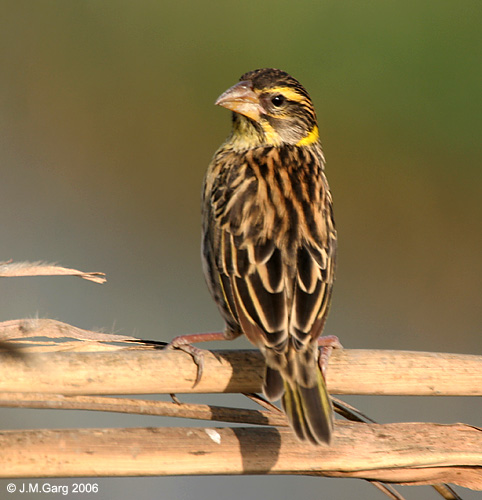| 새로운 사진 | 신문속의 동물소식 | 신기한 동물이야기 | 동물의 소리 | 동물동화상 | 사진 올리기 | 사진 저작권 | English |
|---|
| 재미있는 동물사진 | 괴수/괴어/엽기 동물사진 | 동물이름사전 | 동물목록 | 바깥고리 | 창고입구 | 똑똑누리집 |
|---|
| 이미지 정보 | Original File Name: Black-breasted_Weaver_I_IMG_9557-Bengal or Black-throated Weaver (Ploceus benghalensis).jpg Resolution: 482x500 File Size: 96970 Bytes Date: 2006:11:16 15:45:37 Camera: Canon EOS 350D DIGITAL (Canon) F number: f/6.3 Exposure: 1/200 sec Focal Length: 500/1 Upload Time: 2007:12:29 02:12:00 | |
| 올린이 | 이름 (메일주소): Unknown | |
| 사진 제목 | Black-throated Weaver (Ploceus benghalensis) - Wiki | |
 |
| Email : 카드 | 올린이 | 운영자 사진삭제 정보수정 Admin |
| 설명 | Black-throated Weaver (Ploceus benghalensis) - Wiki
Black-throated Weaver
The Black-throated Weaver, also known as the Bengal Weaver or Black-breasted Weaver (Ploceus benghalensis), is a weaver resident in the northern river plains of the Indian subcontinent. Like the other weavers, the males build an enclosed nest from reeds and mud, and visiting females select a mate at least partially based on the quality of the nest. Distribution Resident or local migrant, endemic to South Asia. From NWFP to Indus Valley in Pakistan to the Gangetic Plains of northern India, to Assam and the Northeast and Bangladesh; commonly seen in the Himalayan terai; patchy to the south in Gujarat and Andhra Pradesh. Local Names: Hindi: Sarbo baya, Bengali: Shor baJa, Kantawala baya. Description Size: Sparrow (ca. 15cm) Appearance: Male in breeding plumage has brilliant golden-yellow crown, white throat and a black band separating it from the fulvous-white underparts. In non-breeding male and female, crown brown like rest of upper plumage; black pectoral band less developed. A prominent supercilium, a spot behind ear, and narrow moustachial streaks, pale yellow. Flocks about cultivation and around reedy margins of tanks and jheels (shallow lakes), or extensive tall grass areas. Behaviour: Polygynous; colonial; on the whole similar to those of the Baya and Streaked Weavers. Courtship: Male constructs the nest single-handedly, with a group of females visiting it during late construction stage, jumping on the helmets and tugging and testing, presumably for strength. If a female appears interested, the male bows low before her, presenting golden crown at her. Flaps wings deliberately and sings softly tsi-tsisik-tsisik-tsik-tsik like chirp of cricket or subdued squeaking of unoiled bicycle wheel. Once female agrees and permits copulation, he quickly finishes the rest of the nest, and she lays eggs inside; he immediately commencing on a second nest nearby to attract other females, and occasionally a third, very rarely even a fourth. Nests not accepted by females may be torn down by the builder himself. Nesting Season: June to September Nest: Similar to the Streaked Weaver; somewhat smaller and normally with shorter entrance tubes. Built in reed-beds in marsh, often moonj or kans (Saccharum spontaneum), with some of the growing reeds incorporated into the dome as support. Entrance tube is somewhat shorter than Baya weavers (up to about 25cm). At the 'helmet' stage of construction a quantity of wet mud or cowdung is daubed thickly along the edge, with bright coloured scarlet or orange flowers or flower petals (Lantana, Lagerstroemia) incorporated; observations suggest that this is part of the courtship rituals and exercise a direct influence on the reactions of the visiting female, both for this species and the Streaked Weaver. Colony: Singly or in scattered groups of 4 or 5; sometimes larger colonies. Eggs: 3 or 4, white, indistinguishable from those of the other two weavers. http://en.wikipedia.org/wiki/Bengal_Weaver
| |||
| 저작권 정보 | 사진의 저작권은 원저작자에게 있습니다. 동물그림창고는 동물관련 사진을 전시할 수 있는 공간만을 제공합니다.사진을 사용하고자 할 경우에는 저작권자와 협의하시기 바랍니다. |
|
|
|
| |||||||
| CopyLeft © since 1995, 동물그림창고. All rights may be reserved. | ||||||||
Stats